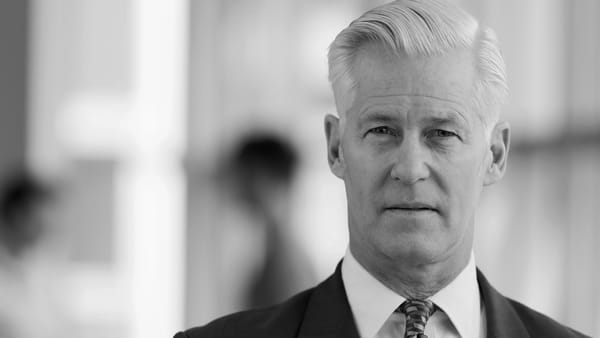Ghosted After the Interview: Why It Happens and How to Prevent It
How missteps in diagnosing issues, creating alignment and controlling the process lead to silence.

Being ghosted after a job interview is a uniquely deflating experience, especially for executives. In my experience, ghosting isn’t just a matter of bad manners or bureaucratic delays. More often than not, it’s a byproduct of missed opportunities during the interview process.
Put simply, companies ghost because they've moved on and can't be bothered to close the loop.
To be clear, I'm not suggesting ghosting is ever acceptable, nor making excuses for a company not having the decency to pick up the phone. But if they've walked away without a second thought, it's typically an indication that you didn't do enough to make a compelling case.
What did they really need? Where were they at internally? What did their other options look like? It is your job to preempt these scenarios during the interview, so that you can clearly articulate your value and position yourself as indispensable.
Here’s why you’re being ghosted and, crucially, how to mitigate it.
You Didn’t Articulate Your Value in Solving Their Problems
Executive interviews aren’t about recounting your resume and past glories. They’re about diagnosing problems and presenting yourself as the solution. Companies hire senior leaders to solve challenges. Your task is to demonstrate, through insight and strategy, how you’ll address those challenges.
How to get it right:
Research, Research, Research
Effective executives come prepared with a deep understanding of the business. Surface-level research isn’t enough.
- Company performance: Study financial reports, earnings calls and key performance metrics. Spot patterns in growth, profitability or strategic shifts.
- Industry trends: Know the market forces shaping their industry. Are competitors innovating faster? Are regulations tightening?
- Stakeholder priorities: Research the CEO, board and senior team to understand their focus areas. Turnaround, growth, operational efficiency, whatever it may be.
You’re identifying pain points. Arrive ready to discuss two or three pressing challenges you suspect they’re grappling with.
Diagnose Their Problems
The best interviews feel like consulting sessions. Use the discussion to validate and expand on your research.
- Ask strategic questions: Don’t wait for them to volunteer their challenges. Lead with insights: “I saw in your earnings report that operating margins are down. What’s driving that trend, and how do you see this role addressing it?”
- Probe for nuance: Listen for gaps in their answers. If they downplay risks, dig deeper: “It sounds like growth in Asia is a priority, but what’s been the biggest hurdle so far?”
- Frame yourself as an insider: Use observations to signal that you’ve already thought about solutions: “From what you've said, a targeted pricing strategy could address some of the margin pressures. Is that something you’re exploring?”
Align Your Experience with Their Needs
Identifying problems isn’t enough — you need to position yourself as the solution.
- Provide specific examples: Reference situations where you’ve addressed similar challenges: “At [Company], we faced similar declining growth. By redesigning our enterprise strategy, we increased our ARR by 35%. I'm happy to talk more about how that might work for you?”
- Quantify your impact: Results matter. Use numbers to demonstrate your track record: “We launched operations in three Southeast Asian markets, generating $30M in first-year revenue and achieving profitability within 18 months.”
- Frame yourself as a strategic partner: Highlight your ability to shape outcomes, not just execute tasks: “What I bring is the ability to design strategies that align with broader corporate goals, not just short-term fixes.”
Control the Conversation
Effective executives don’t just wait to answer questions, they guide the discussion.
- Set the tone early: Open with a statement of intent: “I’d love to explore how my background in [specific area] aligns with the challenges your team is navigating.”
- Steer toward solutions: When the conversation drifts, redirect it to areas where you add value: “That’s an interesting point. I'd expect you're facing [specific challenge]. I'd suggest [X]”
- Close with alignment: End by reinforcing shared goals: “From what we’ve discussed, it’s clear this role requires [specific skill]. I've done this twice before. I’m confident my experience in [specific area] would drive the outcomes you’re looking for.”
You Didn’t Get the Interviewer to Talk Themselves Out of Other Options
Executive-level hiring is a strategic decision that often involves weighing multiple options: external candidates like you, internal promotions, but also not hiring at all.
For you to stand out, the interviewer needs to perceive you as the clear, risk-mitigating, high-value choice. The best way to achieve this? Guide the interviewer into talking themselves out of those other options without you ever overtly disparaging them.
Understand the Alternatives
To differentiate yourself, you first need to know what you’re up against. Interviewers often have other candidates in mind. They may also be considering whether they even need to hire at all or if reallocating responsibilities to existing team members could suffice.
How to Uncover the Alternatives:
Ask directly: Early in the conversation, ask open-ended non-threatening questions that invite the interviewer to share their thought process:
- “What’s prompting you to look outside the organization for this role?”
- “Are there particular qualities you’re seeking that might be challenging to find internally?”
- “What does your ideal candidate look like, and how do you see me fitting into that?”
Read between the lines: Pay attention to subtle hints in their responses. If they emphasize the importance of “cultural fit,” for example, this might suggest internal candidates are in the running. If they stress needing a “fresh perspective,” it might indicate they’ve been burned by internal promotions before.
Position Yourself as the Best Solution
Once you have a sense of the competition, you can tailor your responses to highlight your value while addressing potential weaknesses in their other options. Your goal is to subtly contrast your qualifications with those of internal or external candidates in a way that feels natural and conversational, not as though you’re actively criticizing others.
Leave Them Thinking About You
The goal is to ensure that by the time the interview ends, the interviewer is already mentally slotting you into the role and ruling out the alternatives.
Every question you ask, every insight you share and every answer you give should reinforce your fit and subtly diminish the appeal of other options.
By understanding the alternatives and guiding the conversation effectively, you’ll make it increasingly difficult for the decision-maker to envision anyone else in the role.
You Didn’t Close the Interview
Your ability to close the interview with confidence and purpose can make or break your candidacy. Closing isn’t just about saying “thank you” and waiting for next steps. You need to steer the process forward, creating momentum and showing proactive, decisive leadership.
Too often, candidates leave the interview without firmly anchoring the next phase of the process. This opens the door to ambiguity, email tennis and the possibility of being forgotten altogether.
Dig Deeper
Before you can secure the next steps, you need to ensure that you’ve left no doubts about your fit for the role. Executive hiring is a significant investment, and any unanswered questions or perceived gaps in your candidacy can slow or even halt the process altogether.
How to Elicit Feedback:
- Invite critique directly: Near the end of the interview, ask: “Based on our conversation, do you feel there are any areas where my experience might not align with the needs of this role?”
This shows a willingness to engage in an open dialogue. - Clarify expectations: “What specific outcomes or results would you expect from me in the first twelve months?”
This demonstrates your focus on impact but also gives you a chance to align yourself directly with their expectations.
What to Do with Feedback:
If the interviewer raises concerns or hesitations, address them immediately. For example:
- Concern about cultural fit: “I understand how critical cultural alignment is at this level. At [Previous Company], I made it a priority to immerse myself in the culture from day one. I’d love to hear more about how you define success in cultural integration here.”
- Concern about specific experience: “That’s a fair point. While I haven’t done exactly [X], my experience in [Y] has given me a strong foundation to approach it. I'll share an example…”
By addressing concerns head-on, you eliminate potential barriers and keep the conversation moving forward.
Book the Next Meeting on the Spot
Leaving next steps vague is a recipe for missed opportunities and endless email tennis trying to nail down schedules. Instead, take control of the process by booking the next meeting before the current one ends.
- Propose a specific timeframe: Don’t ask, “What happens next?” Instead, suggest a concrete follow-up: “I’d love to keep the momentum going. Would it make sense to meet next Monday at 2pm to continue this discussion?”
- Offer flexibility: Show that you’re adaptable but proactive: “I’m happy to work around your schedule, but I’d love to reconnect early next week to discuss next steps. Does Tuesday or Wednesday work better for you?”
- Confirm while you’re there: If possible, ask them to pull up their calendar and lock in a time: “Why don’t we take a minute to schedule it now to avoid back-and-forth later?”
If they are hesitant to book in another stage, dig deeper. Is it just a scheduling issue, or is there misalignment?
Suggest Meetings with Other Stakeholders
Another powerful way to close is to position yourself as someone eager to dive deeper into the organization’s challenges and culture.
Tie It to Their Challenges:
During the interview, you’ve likely uncovered specific issues the company is facing. Use these as a springboard:
- “We touched on [specific challenge]. Would it be helpful for me to speak with [key stakeholder] to get a deeper understanding of their perspective? I’d be happy to schedule that this week.”
- “Given the cross-functional nature of this role, it might make sense to have a follow-up conversation with [specific executive]. I’d love to learn more about their priorities.”
Frame It as a Value-Add:
Emphasize how these meetings will help you hit the ground running if hired:
- “I find that meeting with stakeholders early in the process often helps me better align my approach with your organization’s needs. Would it be possible to set up a conversation with [executive or department head]?”
Why This Works:
- It shows initiative: You’re taking the lead in building relationships and gathering insights.
- It reinforces commitment: You’re signalling that you’re already thinking about how to succeed in the role, not just how to secure it.
Leave No Loose Ends
By the time you walk out of the room or sign off the video call, there should be absolute clarity about what happens next. Who will follow up? What are the next steps? When will they happen? If there’s even a hint of ambiguity, take charge and get answers.
Ultimately, being ghosted after an interview often signals that you haven’t done enough to position yourself as the indispensable solution to the company’s challenges.
Act like the leader they need: do the research, diagnose their problems, articulate how you’ll address them and take charge of the interview process. By treating the interview as a consulting session and aligning yourself with their priorities, you leave no room for doubt. Executives who lead the process are the ones who land the role.





